Want to make money selling products online? Find out the 21 best ecommerce platforms in Whop’s ultimate guide.
Key takeaways
- Ecommerce platforms typically charge fees through monthly subscriptions, transaction charges, or percentage-based sales commissions.
- Amazon offers access to a global customer base but limits seller control through strict policies and rules.
- Shopify provides extensive functionality with 1,200+ apps but requires monthly fees starting at $39 plus transaction costs.
- Etsy specializes in handmade and unique products but charges multiple fees including listing, transaction, and processing fees.
- WooCommerce offers a free WordPress plugin but requires separate web hosting and domain purchases.
If you want to make money selling physical goods or digital products online, you’ll need an ecommerce platform.
These platforms support your ecommerce business by providing a storefront, streamlining payments and delivery, and offering marketing tools and integrations. The best ecommerce platforms also include those all-important analytics, so you can keep track of your sales (and all that revenue).
There are lots of ecommerce platforms out there, which makes choosing one a difficult process.
If you want to know the top ecommerce platforms, we’ve listed 21 of the leading options, so you can find the best online home for your business – whatever you want to sell and however big you want to grow.
What is an ecommerce platform?
Ecommerce platforms allow you to set up a dedicated website or storefront for customers to see the details of what you sell. You can set prices and tempt buyers with discounts. The platforms also typically include features such as:
- Choice of payment methods
- Marketing tools
- Delivery options
- Refund/recurring payment functionality
- Integrations
Features vary by platform and also by plan, so be sure to check out the details before you sign up and ensure that you choose a platform with the features you need.
In terms of fees, some platforms offer a “forever free” plan, which usually has limited functionality. Then there are paid platforms, and fee structures on paid plans typically include:
- A single monthly fee (paid annually or month-by-month)
- A fee + transaction charges
- A flat percentage per sale
- A percentage of Gross Merchandise Value (GMV)
BTW: GMV is simply the total value of goods sold over a certain period of time.
As you go through our list of ecommerce platforms, you’ll see we’ve set out the fees involved. This is important, as fees can add up, so part of choosing your ecommerce platform means understanding the costs involved.
The top ecommerce platforms for selling products online
Our list includes a mix of ecommerce platforms, which support all kinds of physical and digital products.
Some entries in the list are familiar names, while others are newer or lesser-known players that might be the right fit for growing your ecommerce business.
Let’s get started with…
1. Whop
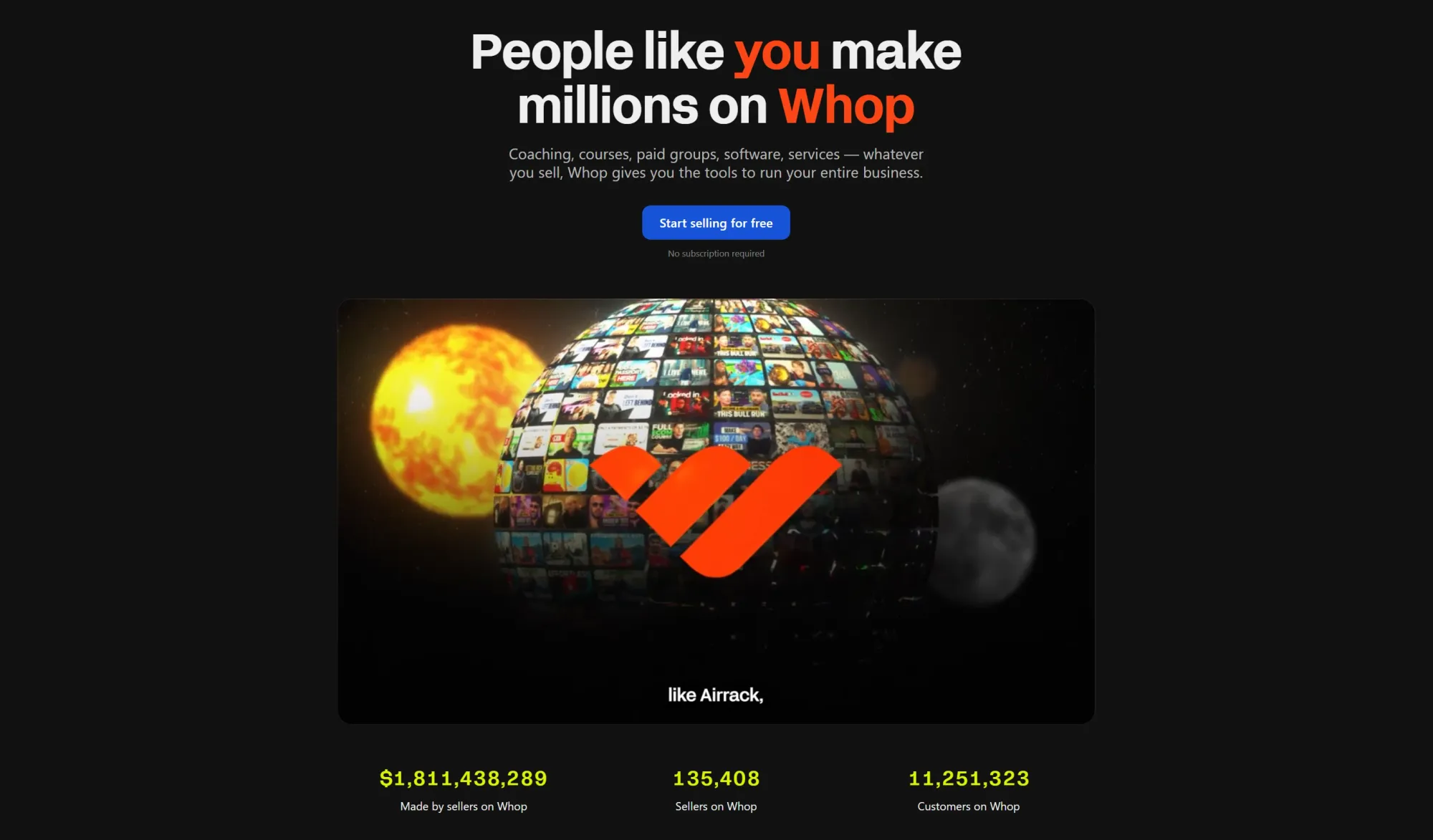
Whop is an ecommerce platform for digital products, including courses, ebooks, and paid communities. Users create their own “whop”, which becomes their home on the internet. With a whop, you can have one central hub to host all of your digital products and services, designed in the way you like with an intuitive app system.
The platform offers payment processing and analytics, as well as useful tools and features like Discord integration.
One of the notable features of Whop is its flexibility. Users can expand their sales offering, adding supplementary products to their hub and maximizing all possible monetization opportunities.
Pricing:
Whop is free to sign up and then charges 2.7% + $0.30 on each transaction, plus payment processing fees.
Best for:
New or experienced online entrepreneurs who want to start or scale a business selling all kinds of digital products. This includes sellers of digital templates, planners, and ebooks; as well as influencers, coaches, tutors, sports cappers, and more. Anyone who has a skill to share can use Whop.
Pros & cons:
| ✅ Sell all kinds of digital products | ❌ Not good for physical products |
| ✅ Easy-to-use interface |
|
| ✅ Start for free | |
| ✅ Pay just 2.7% + $0.30 on sales | |
| ✅ Flexible/scalable | |
| ✅ Discord integration |
2. Amazon
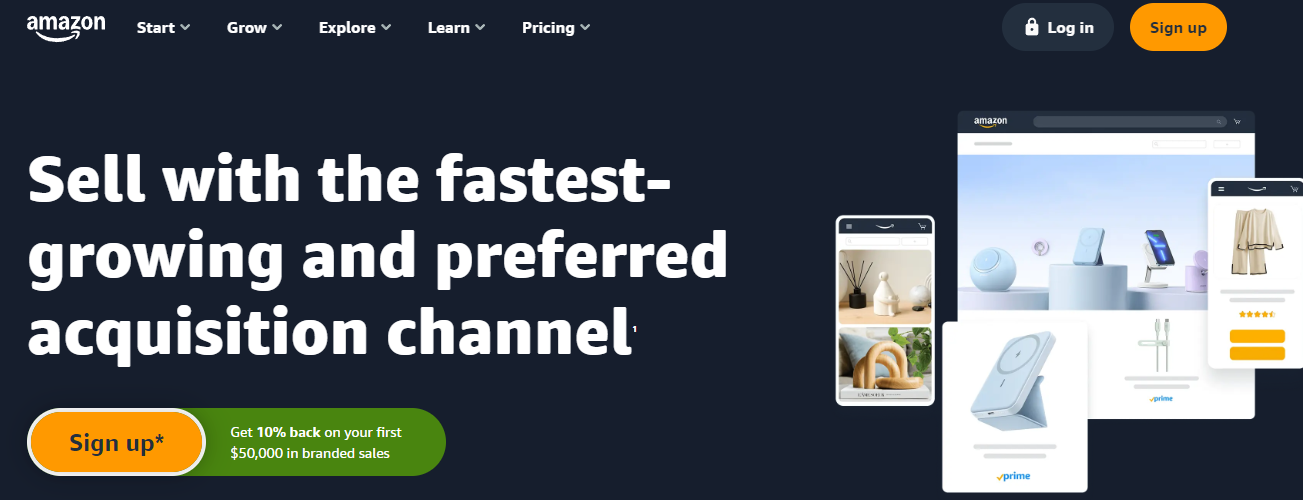
We can’t list the best ecommerce platforms and not mention Amazon. Sell on Amazon and you become part of its vast, global ecommerce ecosystem.
You can sell many types of products, with Fulfillment by Amazon a popular choice for those who want to focus on physical goods. However, there are some things to be aware of before selling on Amazon. These include the competition from other sellers and the various fees that apply.
You will also be subject to Amazon’s policies and rules. This might limit its appeal to sellers who want more control over their ecommerce operations.
Pricing:
Amazon charges $0.99 per sale for individual sellers and $39.99 a month for its Professional selling plan. Other fees will apply, depending on what you sell.
Best for:
Sellers who don’t require full control over their ecommerce business and want to tap into Amazon’s huge global customer base.
Pros & cons:
| ✅ Global customer base | ❌ Multiple fees apply |
| ✅ Supports selling a range of products | ❌ High levels of competition |
| ✅ Handles shipping, returns, etc. | ❌ Limited customization |
| ✅ Brand recognition | ❌ Subject to Amazon's rules & policies |
3. Shopify

Another big player in the ecommerce space is Shopify. The platform supports ecommerce stores across multiple niches. It also has an app store with around 1,200 apps and plugins to add functionality to your store.
Shopify has plenty of features to help you market, sell, and grow. It is oriented to physical products. However, it does support selling certain digital content and products. The main sticking point, certainly for new sellers, is the cost.
Pricing:
Shopify has several standard paid plans. These cost $39, $105, $399, and $2.3k a month. You get a 25% discount if you pay the full year upfront. If you want to get started cheaply, there is a basic $5/month no-frills plan, mostly suited to selling on social media.
Payment fees also apply. These vary slightly by plan but are around 2.9% + $0.30 for online sales. For all plans, Shopify offers a three-day free trial. A current promotion gives you the first month for $1.
Best for:
Entrepreneurs who want to open an online store supported by one of the largest ecommerce platforms out there (and don’t mind paying the fees).
Pros & cons:
| ✅ Several paid plans | ❌ Monthly fees + payment fees |
| ✅ Good for physical products | ❌ Not as good for digital products |
| ✅ Supports scaling | ❌ Limited customization |
| ✅ Lots of features | ❌ No email hosting |
| ✅ Extensive app store | |
| ✅ SEO and marketing tools | |
| ✅ User-friendly platform |
4. Etsy
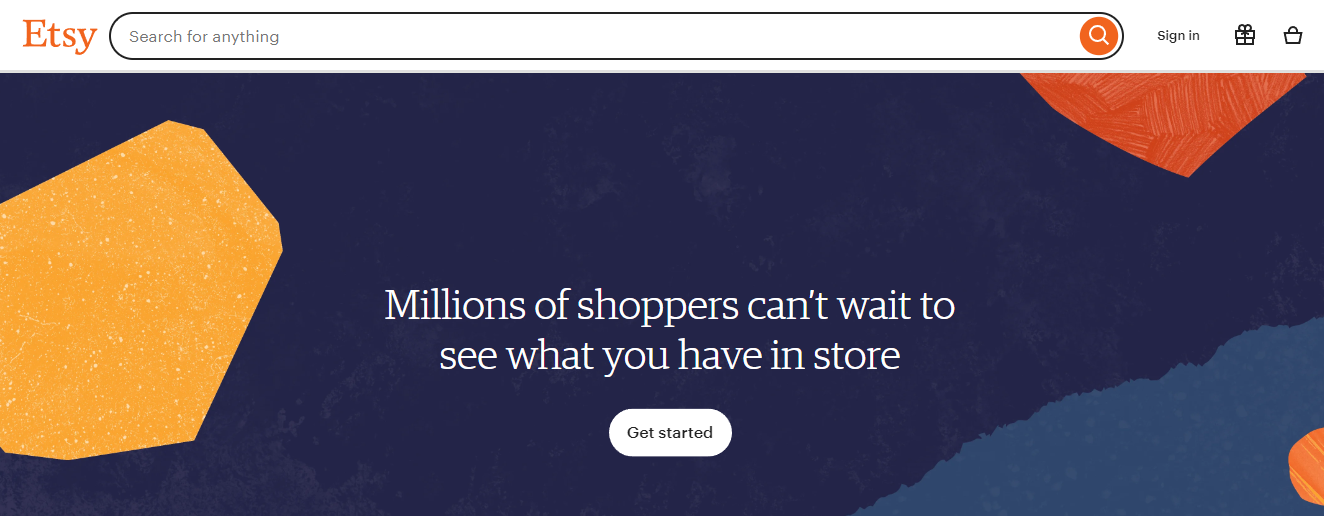
Etsy is a well-known online marketplace that supports selling physical goods and digital downloads. It started out as a platform for selling crafts online, but you can now find a wide range of products on the site.
The platform is popular among individual sellers who likely see Amazon and eBay as the leading Etsy alternatives.
Competition on Etsy can be high and sales inconsistent, but it is a good place to start your ecommerce journey, especially if you want to sell unique, artisanal products.
Pricing:
There are all kinds of fees associated with selling on Etsy. These include a $15 set-up fee, $0.20 per item listing fee, 6.5% transaction fee, and payment processing fee of 3% + $0.25.
Best for:
Individual sellers who want to focus on unique, handmade products or are looking for a complementary platform to sell digital downloads.
Pros & cons:
| ✅ Easy to get started | ❌ Fees can add up |
| ✅ Good for handmade products | ❌ Competition can be high |
| ✅ Can sell digital downloads | ❌ Limited customization |
5. Squarespace

Squarespace is a website builder which offers the ability to create an online store. Use one of the built-in templates to personalize your ecommerce site and use it to sell products, build a community, run courses, or offer digital products.
It offers a range of tools to run email campaigns and engage with social media. However, the website builder is quite limited, in terms of design.
While Squarespace has positive reviews for its ecommerce capabilities, it is still essentially a website builder.
Pricing:
Squarespace offers four paid plans, priced at $25, $36, $40, and $72 when paid on a month-by-month basis. The higher-priced plans are more suited to an ecommerce business. The Business plan ($36) charges a 3% transaction fee. A 14-day free trial is available.
Best for:
Those beginning their ecommerce journey who are looking for an easy way to get their store up and running.
Pros & cons:
| ✅ Easy to use | ❌ May not support growth |
| ✅ Lots of website templates | ❌ Limited design customization |
| ✅ Sell physical or digital products | ❌ Transaction fee on Business plan |
| ✅ Reasonably priced | |
| ✅ 14-day free trial |
6. BigCommerce
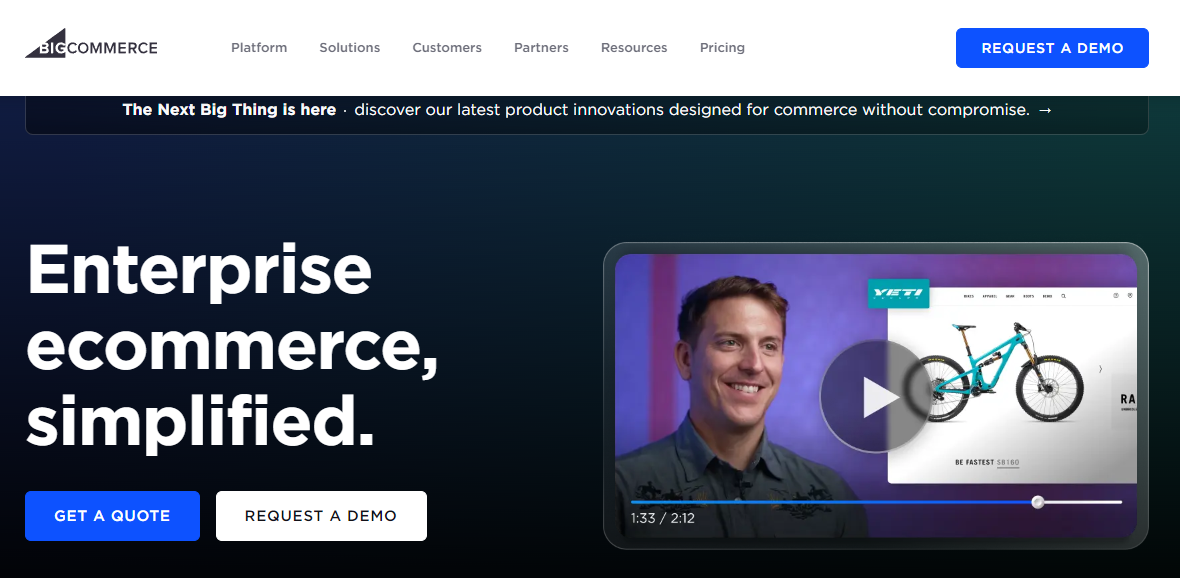
BigCommerce is one of Shopify’s main competitors in the ecommerce space. Create a storefront and sell all kinds of physical or digital products.
It offers a range of ecommerce marketing and brand-building tools, as well as a high degree of customization. However, some of its templates cost extra.
This platform is oriented towards businesses that want to grow to the enterprise level. It supports smaller businesses, too, but the platform is not as user-friendly for beginners as some others on our list.
Pricing:
The paid plans cost $39, $105, and $399 a month (less if you pay annually). There is also a Custom enterprise plan priced on an individual basis. The cheapest Standard plan only allows up to a modest $50k in sales per year. All plans have a fee of 2.59% + $0.49 for online payments. A 15-day free trial is available.
Best for:
Those experienced in ecommerce seeking a similarly priced alternative to Shopify and who want customization options and support to grow to enterprise level.
Pros & cons:
| ✅ Highly customizable | ❌ Not as good for beginners |
| ✅ Supports enterprise-level growth | ❌ Transaction fee applies |
| ✅ 15-day free trial | ❌ <$50k revenue on cheapest plan |
| ❌ Paid templates |
7. Ecwid

Ecwid (by Lightspeed) allows you to sell physical and digital products across multiple platforms. One of its features is its flexibility. It is compatible with website builders, including WordPress, Wix, and Weebly.
The platform offers the ability to sell on social media, such as Instagram and Facebook. It supports things like services and subscriptions, as well as design-based content. You can also list products on Amazon, Walmart, and eBay.
What Ecwid lacks is an all-in-one store builder. As such, it works best when integrated into an existing website builder.
Pricing:
The paid plans cost $25, $45, and $105 when paid monthly, with no transaction fees. There is also a “free forever” plan with limited features, which supports up to five products.
Best for:
Entrepreneurs who want the flexibility to sell physical and digital products across multiple platforms.
Pros & cons:
| ✅ Omnichannel selling | ❌ No all-in-one store builder |
| ✅ No transaction fees | ❌ Limited SEO tools |
| ✅ Forever free plan | |
| ✅ Works with website builders |
8. WooCommerce
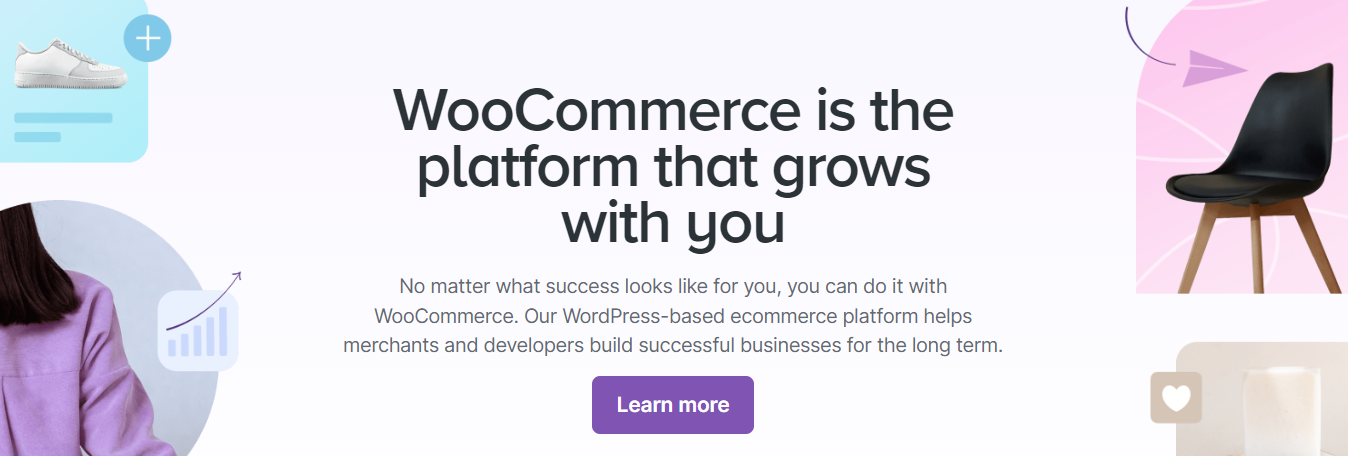
WooCommerce is a slightly different type of ecommerce platform in that it is a plug-in designed to work with a WordPress website. It’s one of the main alternatives to Shopify, largely because it’s free.
This is not an all-in-one solution, as it requires users to set up a WordPress site (including a domain and web hosting). The platform supports physical and digital products.
Basic functionality is limited. However, WooCommerce offers 850+ optional extensions that add functionality. Some of these are free, while others cost between $29 and $299 a year.
Pricing:
The basic WooCommerce plug-in is free. However, users need to pay for web hosting (and a domain) and will likely want to add functionality through paid (and free) extensions and plugins.
Best for:
Less experienced entrepreneurs who want to start cheaply, and those who want to add ecommerce functionality to an existing WordPress website.
Pros & cons:
| ✅ Free WordPress plug-in | ❌ Need to pay for website hosting |
| ✅ Good for beginners | ❌ Limited basic functionality |
| ✅ Works with WordPress | ❌ Some extensions cost money |
| ✅ Adaptable | |
| ✅ 850+ extensions |
9. eBay
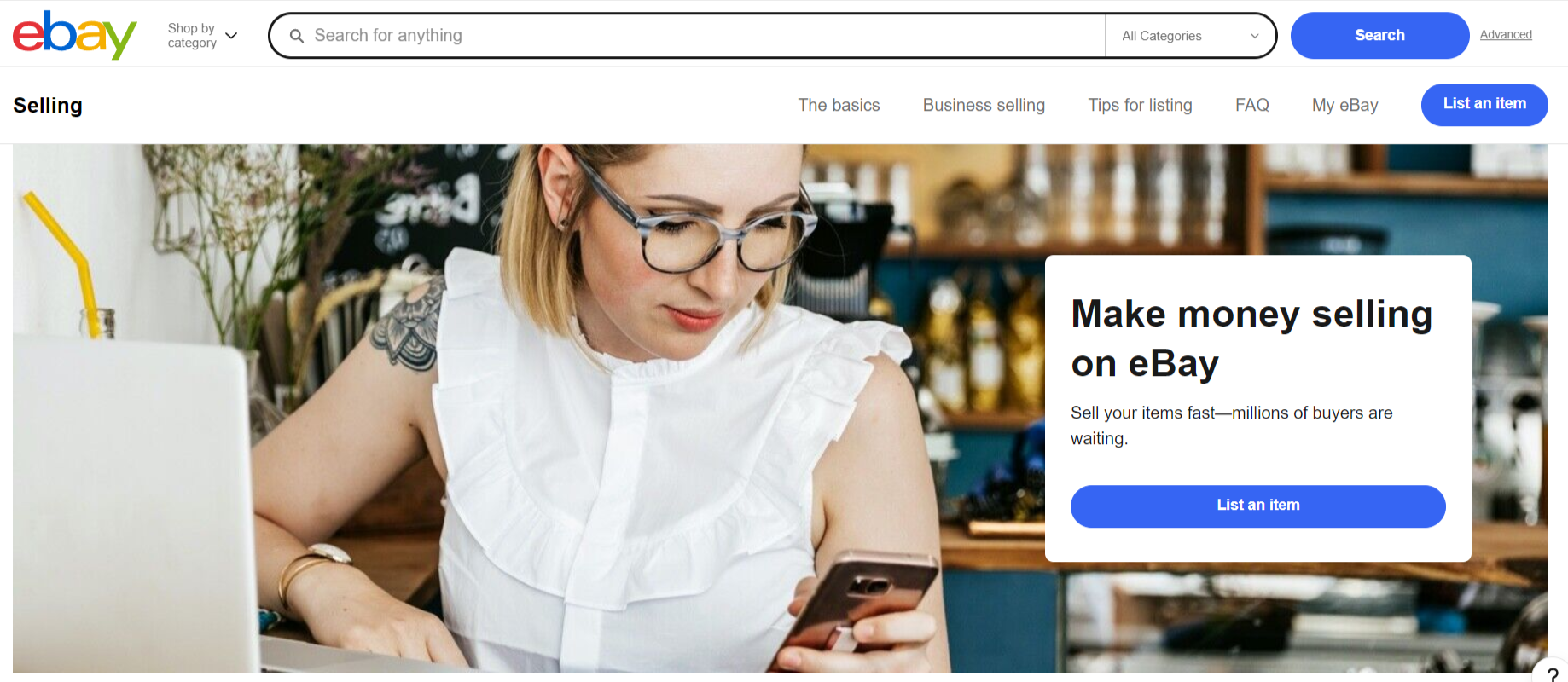
Another significant player in the ecommerce space, eBay began as an auction site for individuals to sell unwanted items. However, it has become a more established platform for businesses to build their brand and tap into a global customer base.
While it is possible to sell digital products on eBay, it remains best for physical goods. You can list your products for sale, set your price (or auction terms), and then ship the items to buyers or use dropshipping.
The main things to consider when selling through eBay are the fee structure and the fact you will be bound by its strict policies. There is also high competition in certain niches.
Pricing:
Various fees apply to selling on eBay. Expect to be charged a percentage of the sale price, plus a fixed fee. You will also be charged per listing and pay transaction fees.
Best for:
Businesses and individuals selling popular physical goods who want to take advantage of an established marketplace.
Pros & cons:
| ✅ Good for physical products | ❌ Not as good for digital products |
| ✅ Easy to get started | ❌ Various selling fees |
| ✅ Large customer base | ❌ Competitive for some products |
| ✅ Shipping can be challenging | ❌ Limited customization |
10. Big Cartel

Despite its name, this is a platform designed for small businesses and artists. The types of products you’ll find listed include jewelry, clothing, and art prints.
It offers a range of free ecommerce store templates tailored to different product categories, but the website builder is quite limited. In fact, that would be a good word to describe Big Cartel’s overall offering: limited.
That’s not necessarily a bad thing, especially as the paid plans are attractively priced. However, it does mean this platform is more suited to smaller-scale ecommerce operations that don’t need the functionality to scale.
Pricing:
Big Cartel offers a forever free plan, as well as two paid plans. When paid on a month-by-month basis, they cost $15 and $30 (you save 20% if you pay annually). The free plan lets you list up to five products. Payment processing fees apply.
Best for:
Boutique sellers and artists looking for an easy and reasonably priced platform to start selling and don’t require advanced features.
Pros & cons:
| ✅ Easy to use | ❌ Basic website builder |
| ✅ Free templates | ❌ Only offers PayPal and Stripe |
| ✅ Free forever plan | ❌ Limited marketing |
| ✅ Reasonably priced paid plans | ❌ Doesn't support scaling |
11. Wix

Our next choice is another website builder, which promotes itself as a place to build your ecommerce business. You can create a storefront design using one of the 900 templates, choose a custom domain, and take advantage of the marketing tools.
Sell physical products, add products from a third-party (or Wix’s own) dropshipping platform, or sell print-on-demand products and digital downloads. The dashboard also lets you manage sales on Google, eBay, Etsy, Amazon, Facebook, Instagram, TikTok and Wish.
There are questions over whether Wix offers the flexibility and scalability demanded by entrepreneurs who want to grow an ecommerce business. However, it has particular advantages for beginners and those looking for a solid ecommerce platform.
Pricing:
Wix has several paid plans, which include a custom domain (for one year) and web hosting. The cheapest is $17 a month, with the other plans priced at $29, $36, and $159 a month. There is no free trial as such, but Wix offers a money-back guarantee if you cancel within 14 days of signing up for a plan.
Wix does offer a free plan, but this does not support ecommerce functionality (just a personal website or blog, etc.)
Best for:
New and smaller-scale online sellers who want a simple drag-and-drop way to build an ecommerce website.
Pros & cons:
| ✅ Easy-to-use site builder | ❌ Limited SEO |
| ✅ Good ecommerce features | ❌ Limited customization |
| ✅ Sell physical and digital products | ❌ Limited scalability |
| ✅ 250+ free and paid apps | |
| ✅ Multichannel selling |
12. Adobe Commerce/Magento

Formerly Magento Commerce, Adobe Commerce is an advanced platform that supports enterprise-level growth for B2B and B2C customers.
Adobe Commerce can handle things like complex shipping, inventory management, and retailers who use warehouse facilities. It supports physical and digital products, including recurring billing (i.e. subscriptions and memberships).
The platform is best suited to mid-size to large businesses that have experience with the technical aspects of running an ecommerce website. There is a free version of Adobe Commerce – Magento Open Source – which is self-hosted.
Pricing:
Adobe Commerce is another costly platform that you'll have to email to get bespoke pricing (research reveals it starts at $22k a year).
Magento Open Source is free to download, but you need to factor in the costs of a domain, hosting, and (if applicable) development to launch your ecommerce store.
Best for:
Experienced entrepreneurs and mid-size to large businesses that need the flexibility and functionality to scale to millions of dollars of revenue a year.
Pros & cons:
| ✅ Flexible platform | ❌ Quite complex |
| ✅ Good SEO & marketing tools | ❌ Costly paid plans |
| ✅ Allows for enterprise-level scaling | ❌ Not for beginners/smaller sellers |
| ✅ Free self-hosted open source option | ❌ Site performance concerns |
13. OpenCart
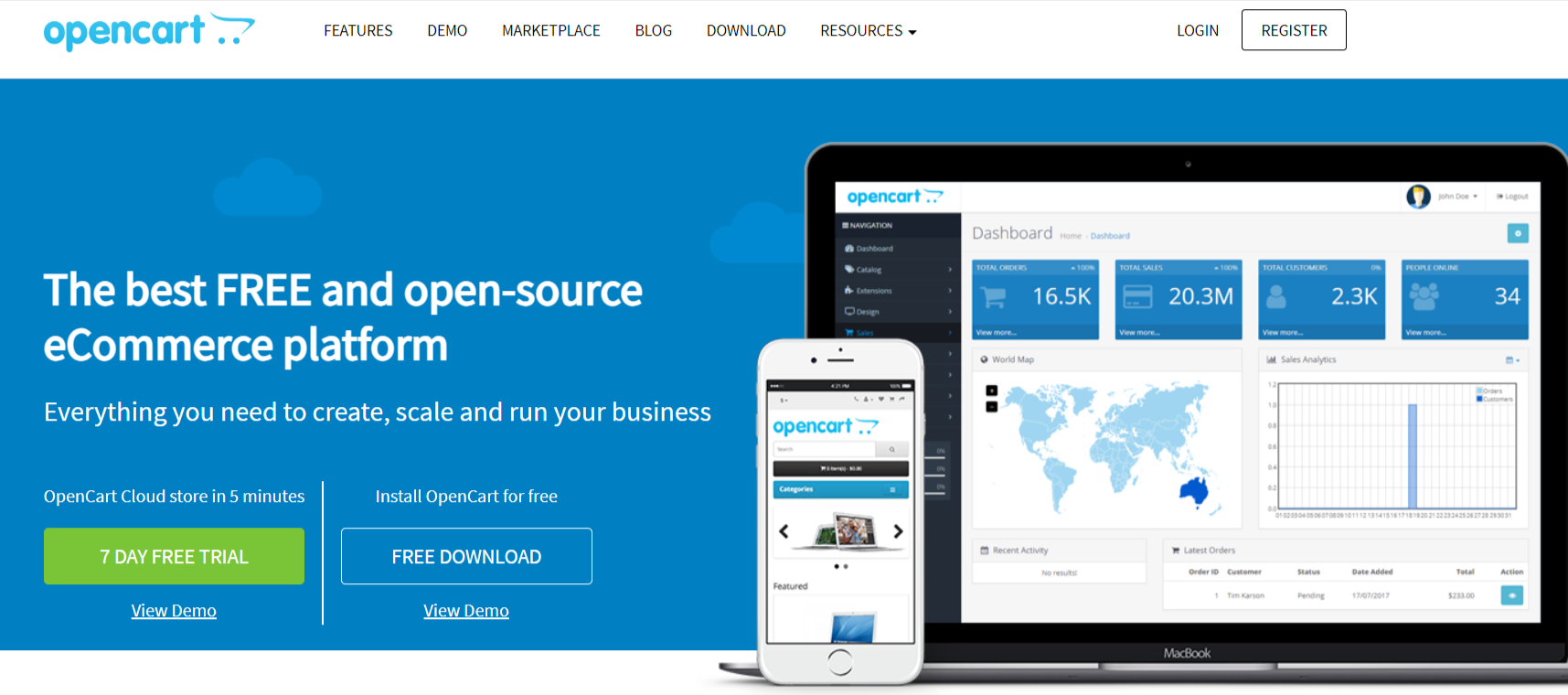
OpenCart is open source software that offers ecommerce functionality, similar to WooCommerce. Unlike Magento Open Source, it does not require advanced technical/development skills.
The software offers shipping, payments, and marketing functionality. Additional features can be added through the free and paid-for extensions. You will need to pay for a domain and web hosting. This can either be via a third-party site (such as WordPress) or through OpenCart Cloud with your site hosted by AWS (Amazon Web Services).
This is one of the best open source ecommerce platforms, offering an impressive selection of features to launch, promote, and grow your business. However, don’t mistake “open source” for truly free, as there are still significant costs involved in getting your customized OpenCart store up and running.
Pricing:
OpenCart software is free to download. If you want the hosting offered by OpenCart Cloud, it costs $59, $99, or $199 a month. There is a seven-day free trial.
If you don’t want the OpenCart Cloud option, you must factor in the costs of a domain and third-party hosting. You might also want to invest in some of the paid-for extensions and a premium OpenCart theme, rather than use a freebie option.
Best for:
Sellers of physical and digital products who are looking for a flexible open source ecommerce platform.
Pros & cons:
| ✅ Free to download | ❌ Hosting and other costs apply |
| ✅ Good selection of features | ❌ Limited customization |
| ✅ Flexible | ❌ Not the most user-friendly platform |
| ✅ Extensions available | |
| ✅ Sell physical and digital products |
14. Volusion

Volusion is a website builder and ecommerce platform. You can build an attractive storefront using its user-friendly interface, and there are various tools and features to help you grow your business.
In addition to its own functionality, it supports various integrations, including MailChimp, Facebook, and Google. It is focused on physical products, with ShipStation as one of its fulfillment partners. However, it also supports digital downloads.
Volusion is a viable alternative to Shopify. Just be aware that the lowest priced plan imposes a quite modest cap on annual sales. This means that scaling requires upgrading to one of the costlier plans.
Pricing:
Volusion’s plans start at $35 a month (up to $50k GMV per year). The higher plans are $79 and $299 a month. Personal is the lowest price plan and limits you to up to 100 products. A 14-day free trial is available.
If you use the Volusion Payments gateway, there are no transaction fees. Alternative payment gateways incur a transaction fee of either 1.25%, 0.65%, or 0.35%, depending on the plan.
Best for:
Ecommerce sellers who want to focus on physical products and are looking for an alternative to Shopify.
Pros & cons:
| ✅ 14-day free trial | ❌ Limited marketing (no blog) |
| ✅ Good for physical products | ❌ Limited promotions |
| ✅ User-friendly interface | ❌ Basic plan only offers 100 products |
| ✅ SEO tools | ❌ Not as good for digital products |
| ✅ Useful integrations |
15. Square Online

Square Online is a popular ecommerce platform that is particularly good for physical goods. It also supports digital products but is not the best place to sell this type of content.
Its plus points include the user-friendly interface and its flexibility. Square Online also supports physical businesses that want to add an online store.
Sellers can create an attractive storefront and take advantage of the various integrations, though these do not include Amazon or Etsy. Some of the extra functionality incurs an extra charge.
Pricing:
Square Online offers a free plan, while the paid plans are $29 and $79 a month (billed as one annual payment). All plans incur transaction fees of 2.9% + $0.30.
Best for:
Entrepreneurs just getting started and looking for an easy way to set up an ecommerce site. It’s also good for sellers who want both an online store and a point-of-sale (POS) system
Pros & cons:
| ✅ $0 plan | ❌ Lacks customization options |
| ✅ Free to start | ❌ Not good for digital products |
| ✅ User-friendly | |
| ✅ Versatile | |
| ✅ POS system integration |
16. PrestaShop

PrestaShop is open-source software, which you can download to add ecommerce functionality to a website. It is similar to WooCommerce but there are some differences.
One of the similarities is that you will need to pay for hosting and a domain. You don’t need a WordPress site to use PrestaShop, though it is compatible. It also works with Bluehost and other hosting sites.
The software includes basic ecommerce functionality. If you want more, additional features can be added through modules, which are just apps under another name.
If your decision on an ecommerce platform is cost-driven, be aware that the paid-for PrestaShop modules (and store themes) are relatively expensive.
Pricing:
PrestaShop software is free to download. Additional costs include web hosting and a domain, as well as a PrestaShop theme and any modules you want to add.
Best for:
Sellers seeking an open source ecommerce alternative to WooCommerce and Magento Open Source.
Pros & cons:
| ✅ Free to download | ❌ Various costs apply |
| ✅ Sell physical and digital goods | ❌ Not the most streamlined platform |
| ✅ Modular customization | ❌ Costly themes and modules |
| ✅ 3,000 store themes | |
| ✅ Beginner friendly |
17. Instagram Shopping

Instagram Shopping lets users of the social media platform browse and buy items in-app. Sellers can set up a storefront with product descriptions and pricing.
Products can be tagged and featured across users’ Instagram feeds, Reels, stories, product mentions, as well as in their profile bio. Instagram is best for physical products, but it is possible to sell digital products, like ebooks, as well.
To use Instagram Shopping, you just need to open a business account. Note that at the time of writing, the in-app checkout feature is only available to selected U.S. business and creator accounts.
Instagram is not the only social media platform to offer ecommerce options. For example, check out Facebook Marketplace, which supports physical products.
Pricing:
You can open an Instagram Shop for free. A 2.9% fee applies for card payments processed through its checkout. You’ll also pay for running Instagram ad campaigns to promote your products.
Best for:
Sellers with social media followers who want to harness Instagram’s large user base and image-driven tools to engage buyers and promote their products.
Pros & cons:
| ✅ Free to set up | ❌ Limitations on what you can sell |
| ✅ Good for physical products | ❌ Checkout feature only for U.S. users |
| ✅ Huge audience reach | ❌ Limited customization |
| ✅ Multiple promotional channels | ❌ Limited ecommerce tools |
18. Commercetools
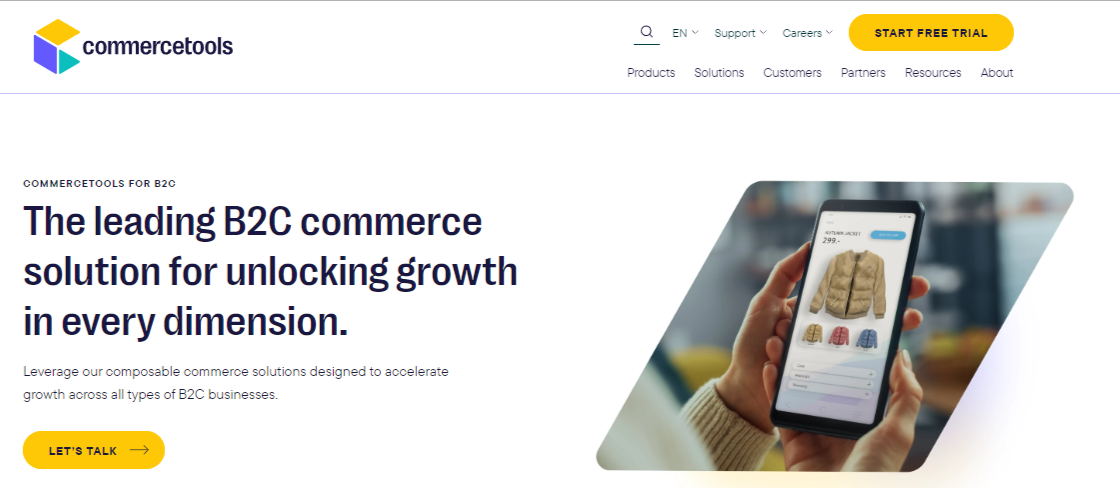
Commercetools is an advanced ecommerce platform that boasts of its use of MACH (Microservices-based, API-first, Cloud-native, and Headless) architecture. That should give you an idea of where Commercetools fits into the hierarchy of ecommerce platforms…
This is not a platform for casual entrepreneurs. It offers serious functionality for clients who need a comprehensive ecommerce solution to handle a high volume of sales.
It offers lots of features and customization options, which means a steep learning curve for users who want to set up their store(s) on the platform.
Pricing:
Commercetools is tight-lipped about its pricing (a bit of digging suggests you’re looking at $40k a year). However, it offers a fully fledged 60-day free trial so customers can try out all of its features.
Best for:
Large businesses that need a sophisticated and scalable ecommerce platform that harnesses the latest technologies.
Pros & cons:
| ✅ Sophisticated platform | ❌ Complex/confusing |
| ✅ Highly customizable | ❌ Steep pricing |
| ✅ 60-day free trial | ❌ Not for new/small sellers |
| ✅ Good for large sales volumes | |
| ✅ Supports enterprise-level growth |
19. Shift4Shop

Previously known as 3dcart and now part of the fintech Shift4, Shift4Shop is an ecommerce platform that bills itself as a turnkey solution. It supports setting up an online store across multiple niches (mostly geared to physical goods).
The platform features a good range of tools and functionality, though reviews flag issues with usability and a lack of customization options.
It is aimed at U.S.-based sellers and also at getting users to adopt the Shift4 Payments solution. This means other payment options are limited.
Pricing:
New sellers pay $39 a month (through PayPal). However, once you reach $1k in customer sales a month, you pay $0. Payment processing fees also apply. Note that if you drop below $1k in monthly sales, Shift4Shop will impose a fee.
This is opposite to how fee structures usually work. However, Shift4’s primary business is as a payment processing solution, which is how it makes money. The more sales Shift4Shop users make, the more payments it gets to process.
Best for:
U.S.-based sellers who have some experience with setting up ecommerce stores and can deal with the odd fee structure.
Pros & cons:
| ✅ Free once sales reach $1k | ❌ No free trial |
| ✅ Good range of features | ❌ New users pay a monthly fee |
| ✅ Marketing & SEO tools | ❌ Not the most user-friendly platform |
| ✅ Lots of store theme templates | ❌ Only for sellers in the U.S. |
| ❌ Limited payment options |
20. Salesforce Commerce Cloud

Formerly known as Demandware, Salesforce Commerce Cloud offers an advanced AI-driven, cloud-based platform for merchants to sell online.
Salesforce Commerce Cloud supports multiple storefronts and tools including inventory management. The platform integrates with the Salesforce suite. It offers a B2B ecommerce platform. However, B2C Commerce is focused on selling directly to customers.
Household name brands such as Coca-Cola and L’Oreal use Salesforce. This lets you know it’s more suited to large businesses and those with big plans to scale.
Pricing:
The basic B2C Commerce package is charged at 2% of GMV (billed annually). This includes five storefronts. The B2C Commerce Plus plan is 3% GMV, with unlimited stores.
Users can also choose to pay extra to add one of three Success Plans, which are bundles of resources and other support.
Best for:
Experienced entrepreneurs and businesses that want a platform to support scaling their ecommerce operations.
Pros & cons:
| ✅ Offers scalability | ❌ Overcomplicated for some users |
| ✅ High level of functionality | ❌ Users flag integration issues |
21. Gumroad

Finally, Gumroad is an ecommerce platform that focuses on digital products. Unlike some of the other platforms on our list, it has a more laid-back style. The site features colorful graphics, cartoons, and an artsy “marketplace” feel.
The platform is easy to use but lacks customization options compared to some of its competitors. It’s also not great for selling everything, especially if you want to complement your ecommerce offering with e-learning products.
However, it boasts that its creators made over $3m in total sales over seven days – so it’s proving a popular way to make money selling online.
Pricing:
Gumroad charges a flat 10% on each transaction. There’s no monthly fee (or free plan). However, you’ll also pay card processing fees of 2.9% + $0.30 per sale. This will take a significant portion of your revenue.
Best for:
Smaller scale creators who want to focus on digital products and don’t mind paying 10% on each sale.
Pros & cons:
| ✅ Sell a range of digital products | ❌ High 10% fee on transactions |
| ✅ User-friendly interface | ❌ Cannot sell physical products |
| ✅ Good for smaller-scale creators | ❌ Not great for courses |
| ❌ Lack of customization options |
Choose the #1 ecommerce platform: Whop
Whether you’re a new or experienced entrepreneur looking for the right home for your online business, you’ve come to the right place.
Our easy-to-use platform supports selling all kinds of digital products, from ebooks and podcasts to communities and memberships – and more. Whop is for new and experienced creators alike.
Start for free today, then pay just 2.7% + $0.30 on sales.
Join thousands of fellow entrepreneurs making money on Whop – your one-stop shop for starting and growing the online business of your dreams.
Ecommerce FAQs
Is ecommerce still profitable?
Yes! In 2025, global revenue from ecommerce is expected to exceed $7tn, comprising a whopping 25% share of total sales.
What are some good products to sell online?
If you’re just starting out, digital products can be the best option. These have lower overheads and none of the hassle of physical delivery. If you prefer to sell physical goods, popular ecommerce niches include green/eco-friendly, pets, and health & wellness.
Check out our post that gives you a massive collection of ideas for your ecommerce business.
Can I change ecommerce platforms?
Yes. You can migrate to a different platform, but it’s a significant undertaking that can lead to disruption for you and your customers. That’s why it’s important to do your research before signing up and to make sure you choose a platform that will support your business in the long term.
Also, take advantage of the free plans and free trials offered by ecommerce platforms. This way, you can test the features and functionality before building and launching your ecommerce business.
Looking for multi-vendor ecommerce platforms? Read this guide.
A word on B2B ecommerce platforms
Our list of ecommerce platforms focuses on the business-to-consumer (B2C) space, where you sell directly to customers. However, you can also find business-to-business (B2B) ecommerce platforms.
There is some overlap with the B2C space, but B2B platforms are designed for businesses to sell to one another, such as wholesalers, manufacturers, and distributors.
Example B2B ecommerce platforms include:
- Amazon Business
- Shopware
- CS-Cart
- Shopify Plus
- WooCommerce B2B
- BigCommerce
- SuiteCommerce
- Alibaba
B2B ecommerce platforms often have more sophisticated integrations designed to complement complex supply chains. They are set up to handle things like bulk shipping, cross-border trade, and inventory management.

For the majority of online entrepreneurs, the aim (at least initially) is to create a B2C ecommerce business.
So, what are the best ecommerce platforms to sell products directly to customers? Here’s our list of 21 sites to consider.



